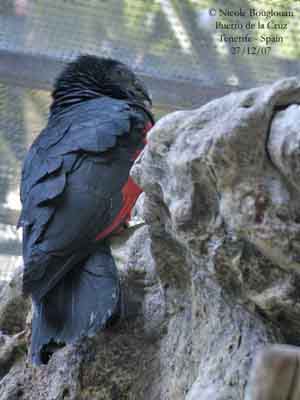
Pesquet’s Parrot
Psittrichas fulgidus
Psittaciforme Order - Psittacidae Family
BIOMETRICS:
Length: 46 cm; Weight: 600 à 800g
LONGEVITY: up to 40 years
DESCRIPTION:
Pesquet’s Parrot has « vulture-like » attitude mainly in flight. This beautiful black and red parrot is endemic to New Guinea, and the only member of the tribe Psittrichadini.
Adult male has black upperparts with contrasting broad red wing bar on greater and median wing coverts. We can see an indistinct red crescent on rump. Short, squared tail is black. Broad wings are rounded.

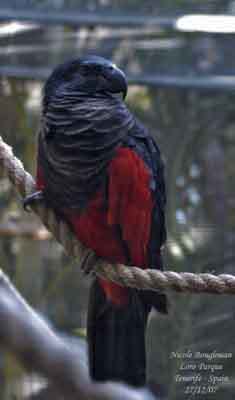
Pesquet’s Parrot has featherless face, probably adapted to its feeding behaviour, because feathers could be matted with the fruit pulp.
Head is dark in colour, with bare grey-black face. We can see a small red patch behind the dark reddish-brown eyes. The black bill is hooked, with relatively long upper mandible. Legs and feet are grey.
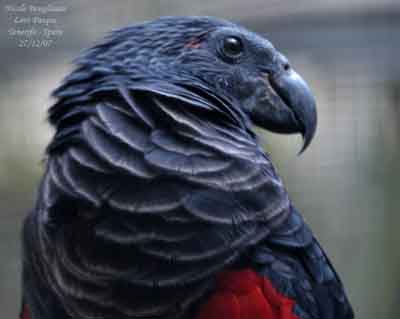
Both sexes are similar, but female is slightly smaller than male, and she lacks the red spot behind the eye.
Juvenile has duller red parts of plumage. It has the red spot behind the grey-brown eyes.
VOICE: SOUNDS BY XENO-CANTO
Pesquet’s Parrot utters harsh, screeching calls, like cockatoos, but softer and more high-pitched. It also gives disyllabic nasal squeak.
HABITAT:
Pesquet’s Parrot lives in restricted areas with hills and lower montane forest, from 600 to 1200 metres of elevation. It is also found in tall secondary growth.
RANGE:
Pesquet’s Parrot lives in the mountains of New Guinea, between 600 and 1500 metres, occasionally lower or higher.
BEHAVIOUR:
Pesquet’s Parrot is fond of fruits of certain figs (Ficus). These fruits have hard shell. But it also takes softer fruits, blossoms and nectar.
Pesquet’s Parrot is usually seen alone, in pairs or in small groups. They are noisy, often flying in small flocks above the canopy, or perched in the higher branches of tall trees. This species likes to sit during long periods on exposed bare branches, or on treetop above the surrounding forest area.
Pesquet’s Parrot moves from branch to branch by jumping, in jerky motion, and flicking rapidly its wings.
This species is sedentary in its range, but it can perform some movements according to the season and the food resources.
FLIGHT:
Pesquet’s Parrot has strong flight with rapid and shallow wing beats, which alternates with short glides.
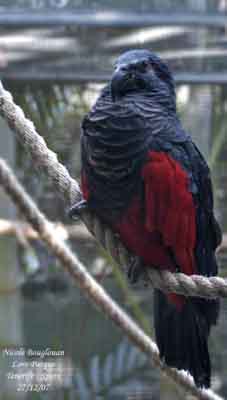
REPRODUCTION:
Breeding season occurs from February to April-May.
Little is known about the reproduction of Pesquet’s Parrot in the wild.
Nest is situated in large hollow tree.
Female usually lays two eggs. Incubation lasts about 27 to 31 days.
Fledged young can be seen in December.
DIET:
Pesquet’s Parrot feeds mainly on fruits of certain Figs (Ficus), but also on mangoes and other softer fruits. It also consumes blossoms, nectar and flowers of Freycinetia.
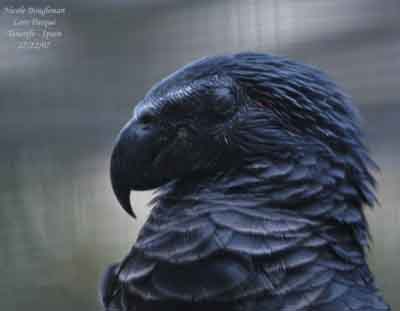
PROTECTION / THREATS / STATUS:
Pesquet’s Parrot is threatened by hunting pressure. It is highly prized for its feathers which serve for ceremony hats, its skin is used for various items for tourists, and it is also killed for consumption.
Trapping for bird trade and deforestation are two other important threats.
Pesquet’s Parrot is evaluated as Vulnerable on the IUCN Red List of Threatened Species.
Fr: Psittrichas de Pesquet
All : Borstenkopf
Esp : Loro Aguileño
Ital : Pappagallo di Pesquet
Nd : Borstelkoppapegaai
Russe : Щетиноголовый попугай
Photos et texte de Nicole Bouglouan
Sources:
HANDBOOK OF THE BIRDS OF THE WORLD vol 4 by Josep del Hoyo-Andrew Elliott-Jordi Sargatal - Lynx Edicions - ISBN: 8487334229
PARROTS OF THE WORLD – An Identification Guide – by Joseph M. Forshaw – Princeton University Press – ISBN 0691092516
Wikipedia (Wikipedia, The Free Encyclopedia)
BirdLife International (BirdLife International)